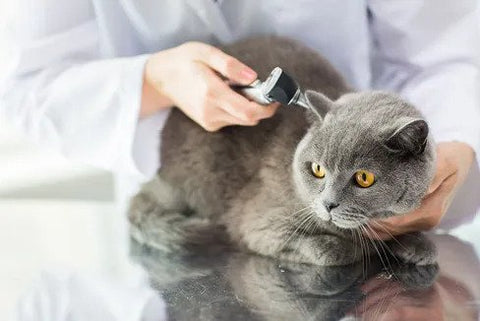Otodectes cyanotis, commonly known as ear mites, frequently infest cats, leading to a generally mild parasitic ailment. Although labeled "ear" mites, these parasites can invade areas of your feline's body beyond just the ears and are highly infectious.
Cats tend to excessively scratch at their ears and vigorously shake their heads when affected. Some might even shake their heads to the extent that they develop a hematoma caused by a burst blood vessel that leads to blood accumulation and swelling of the ear flap.
While young cats are often the primary victims of ear mites, felines of all ages can be affected.
Moreover, some cats might exhibit hypersensitivity reactions to ear mites, causing intense ear discomfort.
Causes Of Ear Mites In Cats
Ear mites can quickly spread, meaning if your feline interacts closely with another animal harboring these parasites, there's a risk of transmission. The transfer is possible from mother cats to their kittens or even across different animal species. Yet, it's reassuring that humans remain unaffected by this mite.
Symptoms Of Ear Mites In Cats
Cats infested with ear mites often exhibit the following signs, primarily due to the discomfort and itchiness:
- Persistent scratching of the ears, head, and neck
- Regular shaking of the head
- The presence of a dry, grainy, dark, or reddish-brown residue within the ear passage
Should the ear mites migrate to other parts of your feline's body, you might observe:
- Flaky and crusty skin around the neck, rear, and tail
- Widespread itching and persistent scratching.
Treatment For Ear Mites In Cats
Ear mites can be effectively addressed using FDA-endorsed eardrops like Acarexx, MilbeMite, or Otomite Plus.
Before administering the treatment, ensure that your cat's ears are meticulously cleaned using a cat-specific ear cleaner. This action aids in eliminating any residual debris, enhancing the efficacy of the treatment.
Should the mites spread to other body regions, your vet might recommend anti-flea treatments that counteract mites, such as Advantage Multi or Revolution. While Bravecto is productive in dealing with ear mites, it isn't officially labeled for this use.
If any pet in your home, be it a cat, dog, or ferret, is identified with ear mites, it's crucial to treat every cat, dog, and ferret present to prevent further spread. The silver lining is that ear mites don't thrive well outside their animal hosts or in diverse environments, eliminating the need for treating your household.
Always consult your veterinarian, as they will recommend the optimal product tailored to your pets' needs.
Management And Recovery Of Ear Mites In Cats
Overcoming an ear mite infestation typically spans between 7 to 10 days. Regularly applying products like Advantage Multi, Revolution, or Bravecto can help minimize the chances of reinfestation. Consult your veterinarian for the most suitable product for your pets' needs.







